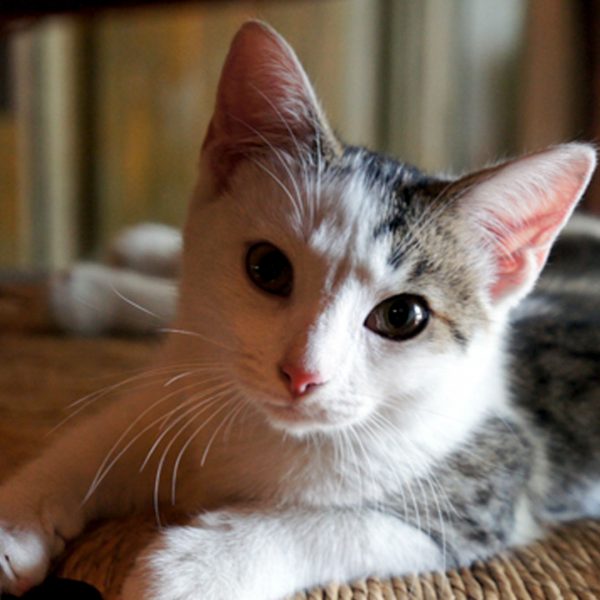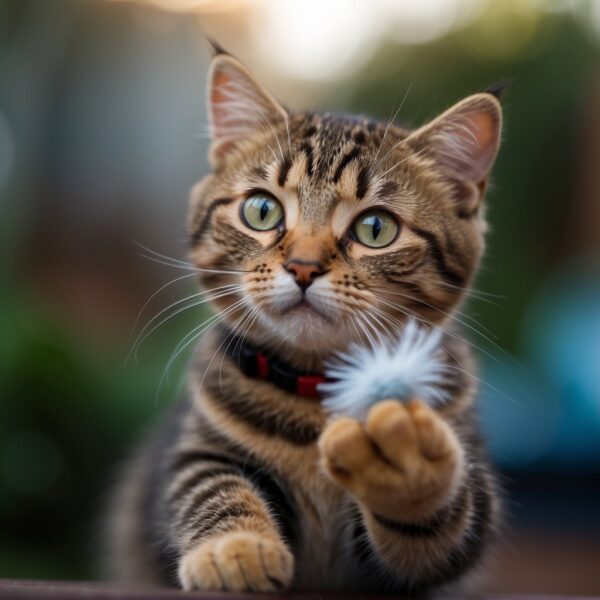
Why Cats Are So Cute: Science Behind the cute factor
Why cats are so cute is a blend of evolutionary biology and societal influences. Certain physical characteristics of cats, such as their big eyes, small noses, and soft fur, align closely with the features that humans are hard-wired to find endearing. This innate response to features that resemble those of human infants elicits a caregiving behavior, which is a key factor in the special bond many people form with cats.
Moreover, the behaviors of cats significantly contribute to their cuteness factor. Their playful antics, curious nature, and the tendency to exhibit vulnerability through behaviors like purring or kneading have an undeniable appeal. A mixture of independent and affectionate traits makes cats compelling companions and often irresistible to watch. This has been further amplified by the cultural impact of cats, which is evident in their prominent presence across various media platforms.
Key Takeaways
- Certain physical characteristics of cats trigger a caregiving response in humans.
- Cat behaviors contribute to their perceived cuteness and enhance human-feline bonds.
- The cultural prominence of cats in media has amplified their appeal.

The Science of why cats are so cute
The allure of cats’ cuteness is not just a cultural phenomenon, but rather a scientific matter deeply rooted in human psychology and the biology of domesticated animals.
The cute factor: Evolution of cat Cuteness
Scientists have explored the concept of cuteness and its impact on human behavior. A pivotal figure in this research is Konrad Lorenz, an ethologist who proposed the baby schema theory, suggesting that certain infantile features such as large eyes, round faces, and small noses evoke a caretaking response in adults. This baby schema is prominently displayed in the faces of many cat species and triggers affection and protective instincts from their human counterparts.
Researchers have expanded on Lorenz’s theory to understand how viewing these traits in cats can stimulate the brain. Studies highlight the activation of the pleasure center in the brain upon encountering cute animals, releasing neurotransmitters like dopamine and oxytocin. Dopamine is associated with the reward circuitry and pleasure, while oxytocin, often referred to as the ‘love hormone,’ reinforces bonding and trust.
These reactions underscore the evolutionary advantages of cuteness; humans are more likely to care for and protect those animals that elicit a positive emotional response. In terms of cats, their enduring cuteness might have given them an edge in forming symbiotic relationships with humans. The mutual benefits of such relationships have likely propelled the evolution of cuteness traits in feline species, ensuring their survival and continued care.
Through careful examination, the science of cuteness unravels the intricate bond between humans and cats, demonstrating that the traits deemed adorable have tangible effects on human neurochemistry and evolutionary dynamics.

cute cat Features That Elicit Adoration
Cats possess a range of physical features that are widely perceived as adorable. These characteristics, from their expressive faces to the texture of their fur, evoke the kind of adoration that cat lovers find irresistible.
cute cat Facial Characteristics
Eyes: Cats have large, prominent eyes which often appear childlike and elicit a nurturing response from humans. Their big eyes are a central part of their facial features, capable of displaying a variety of emotions that connect deeply with people.
Whiskers: A cat’s whiskers not only serve a practical sensory function but also add to their cuteness. The positioning and subtle movements of the whiskers contribute to the expressiveness of a cat’s face.
Fur and Coat
Texture: The softness of a cat’s fur is a pleasant tactile experience, making them a comfort to pet and snuggle with. The fur varies between breeds, from the sleek, short-haired to the fluffy, long-haired coats.
Patterns and Colors: The array of patterns and colors seen in cats’ fur—from stripes and spots to solid hues—accentuates their physical appeal and adds to their uniqueness.
Paws and Tails
Paws: The underside of a cat’s paws, known as paw pads or “toe beans,” are soft to the touch and often a different color than the rest of the limb, adding to the charm of their paws.
Tails: Cat tails can communicate emotions and add an element of cuteness with their various movements. Whether a tail is bushy, sleek, long, or short, it is an adorable appendage that often captivates onlookers.
Why cats are Cute: Behavioral Traits of Cats

Cats display a complex range of behaviors that often contribute to their perception as cute. These traits are not just endearing but are key forms of communication and bonding behaviors that have evolved alongside their domestication.
Communicative Signals
Cats utilize a variety of vocalizations to express their needs and feelings. Meows are typically directed at humans and can indicate anything from hunger to a desire for attention. Each cat’s meow is unique, and they can vary the pitch, length, and volume of their meows to convey different emotions. Purrs, on the other hand, are often associated with contentment and can signify a relaxed emotional state, but they may also be used to comfort themselves when ill or injured.
Blinking in cats can be a form of communication, with slow blinks being a sign of trust and affection towards their owners. This subtle signal can reciprocate or initiate interaction, strengthening the bond between cat and human.
Playful and Affectionate Behaviors
Cats exhibit playfulness that often reflects their predatory instincts. They may stealthily stalk a toy mouse, which is not only charming but crucial for their physical and mental well-being. Such behaviors can also manifest as cute aggression, where an individual is overwhelmed by cuteness and feels an urge to squeeze or playfully ‘bite’ the adorable subject.
Affection in cats is demonstrated through various physical actions. Nudging, head-butting, and curling up in a person’s lap are all behaviors that signify trust and fondness. The solicitation purr is a specific type of purring mixed with a soft cry or mew, which cats use to signal their desire for attention or food—a sound that is often difficult for humans to ignore due to its endearing quality.
Through these behaviors, cats communicate their needs, emotions, and intentions, often in ways that humans find irresistibly cute. These instinctual traits not only serve practical purposes but also help create deep connections with their human companions.

Human and Cat Interactions
Interactions between humans and cats are multifaceted, often defined by mutual trust and the pleasure derived from their companionship. Cat owners frequently describe a unique bond that develops through daily interactions, such as grooming and expressive communication.
The Bond Between Cats and cat parents
The bond between cats and their owners is built on a foundation of trust and nurture. Owners engage in social grooming, an activity that deepens the connection and contributes to a cat’s wellbeing. Cats return this affection, often seen through their expressive eyes and body language, signaling comfort and trust. Regular grooming sessions reinforce this bond, as cat owners interpret these actions as signs of affection.
The Therapeutic Effects of Cats
Cats are often considered a form of therapeutic medicine for their owners. The simple act of petting a cat can lead to a reduction in stress and anxiety levels. This has been linked to the pleasure response in the human brain. Moreover, the rhythmic nature of a cat’s purr can have a calming effect, which some liken to a form of nurture and comfort. The interactions with cats extend beyond mere companionship, serving as a therapeutic presence in the lives of many cat owners.
Cultural Impact of Cats
Cats have firmly established their status as a dominant pop culture icon, influencing various aspects of media and everyday life.
Cats in Media
Cats are a constant presence in media, lauded for their roles stretching from viral sensations to symbols with significant cultural resonance. The popularity of cats in digital content is undeniable; YouTube videos featuring felines often amass millions of views, proving the significant role cats play as a source of entertainment and emotional connection for people worldwide.
Popular Cat Breeds: Among the content celebrated online, certain cat breeds have gained particular notoriety for their distinctive features. For instance, brachycephalic breeds like the Persian and the Exotic Shorthair, known for their squished faces, have a prominent presence on social media platforms due to their unique and often deemed ‘cute’ appearance.
- Domestic Breeding Programs: Reflective of their popularity, various domestic breeding programs prioritize producing cats that align with the aesthetic preferences of potential pet owners. This has caused a surge in demand for breeds with pronounced features such as short muzzles and folded ears, characteristics that consumers often find adorable.
The proliferation of cats across media channels speaks volumes about their role as a beloved pet and cultural icon. Their adorable antics and distinctive looks continue to capture hearts, cementing their place within the tapestry of pop culture.
Why cats are so cute: Frequently Asked Questions
The allure of cats is often encapsulated in their physical and behavioral traits that evoke a sense of affection in humans. These frequently asked questions delve into the specifics of what makes cats so endearing.
What specific features make cats appeal to human beings?
Many people find the physical attributes of cats, such as their soft fur, large expressive eyes, and small size to be inherently appealing. These features often trigger a caring instinct akin to that elicited by human infants.
How has the evolution of cats influenced their cuteness?
Throughout their evolution, cats have retained certain juvenile traits, a process known as neoteny. This includes large eyes relative to their head, which is a trait typically associated with kittens, and has bolstered their cuteness in the eyes of humans.
In what ways do cats display cuteness while sleeping?
Cats often sleep in curled-up positions and contort into various cozy and seemingly vulnerable shapes. This can make them appear even more endearing and in need of protection, which many people find adorable.
Is there any scientific evidence that cats understand their own cuteness?
There is no definitive scientific evidence to suggest that cats have a conscious understanding of their own cuteness. However, they may learn that exhibiting certain behaviors, such as purring or nuzzling, can elicit positive responses from humans.
How does the cuteness of cats compare to other domestic animals?
Cuteness is subjective; however, cats are often considered cute for their graceful movements, playful behaviors, and expressive faces. These traits can be different or more subtly expressed in other animals, affecting how their cuteness is perceived by humans.
Why do people often attribute a higher level of cuteness to cats over dogs?
Some people may attribute a higher level of cuteness to cats than dogs due to cats’ independent nature, their small and delicate features, and their tendency to engage in entertaining antics. Cats’ ability to maintain an air of mystery and aloofness can also enhance their charm compared to the more openly affectionate and loyal nature of dogs.